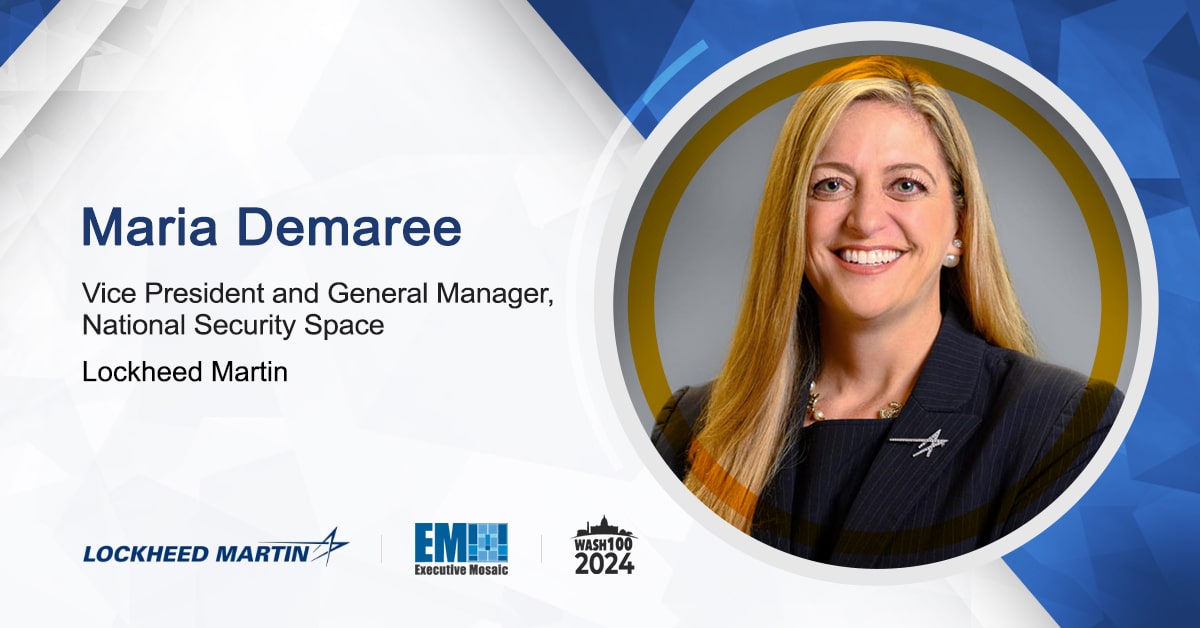Artificial intelligence is changing the game across all domains and industries, including in space. Maria Demaree, vice president and general manager of national security space at Lockheed Martin, spoke with Executive Mosaic about how AI is impacting missions from CJADC2 to space and more.
Demaree, a two-time Wash100 Award winner, has been with Lockheed Martin for over three decades, and she has occupied her current position for nearly a year. At Lockheed, she leads a multi-billion dollar portfolio and 8,300 employees focused on delivering integrated end-to-end solutions, high-performance systems and critical space architectures supporting national security missions.
Read below for Demaree’s full Executive Spotlight interview.
Tell me about the current state of the artificial intelligence market. Where are you seeing new opportunities in AI, and where do you think the market is heading?
Artificial intelligence and machine learning are transforming how humans and machines work together and are giving us the ability to create unprecedented data value chains, at increased speed, for our nation’s warfighters and intelligence community end-users to help them achieve national security imperatives across all domains.
Moreover, AI/ML integrated into satellite technology will further revolutionize defense capabilities in various ways including: providing enhanced space domain awareness; augmented coordination and secured communications; improved targeting and precision; and will be central to creating competitive advantages by operationalizing Combined Joint All Domain Command and Control, or CJADC2 concepts.
What’s your outlook on the global defense landscape? What significant changes or trends are you seeing, and how are those factors moving the GovCon market?
As noted, AI and ML are top of mind, and will allow the deployment of human capital within the defense enterprise to tackle additional emerging challenges.
In addition, the GovCon market is placing a premium on enhanced SDA capabilities including Deep Space Advanced Radar Capability (DARC), which is why we are excited about what we are learning from our ongoing Civil Commercial Space-led technology pathfinders: Demonstration Rocket for Agile Cislunar Operations (DRACO), which is developing a first-of-its-kind Nuclear Thermal Propulsion (NTP) system; and Joint Emergent Technology Supplying On-Orbit Nuclear (JETSON), which is maturing high-power thermal Nuclear Electric Propulsion (NEP).
Needless to say, the potential crossover and adoption of those next-gen propulsion technologies across the national security establishment is an absolute game changer and will give our customers the ability to maneuver without regret — moving spacecraft away from threats while enabling the execution of dynamic space operations from different orbits without fear of fuel depletion.
And lastly, the demand for increased interoperability between our joint warfighters’ systems with international allies’ systems is influencing the GovCon market, which is why we are doubling down on CJADC2 and autonomous crewed and uncrewed teaming technologies that employ an open standards approach.
What do you think are the most pressing national security threats we’re facing today? How is Lockheed Martin addressing these threats?
The most pressing threats are coming from nation-state competitors looking to diminish U.S. global influence.
To address those threats, we are innovating with urgency to provide our customers with world-class mission integration and full-spectrum resiliency integrated into 21st century security system-of-system capabilities that reduce sensor-to-shooter timelines and provide unrivaled decisional velocity to warfighters to outmaneuver, outpace, outlast and outsmart potential adversaries.
And we’re doing it with a ‘Show More, Tell Less’ approach, leveraging self-funded independent research and development (IRAD) to mature technical readiness levels faster in order to put sought after capabilities in the hands of warfighters at the tactical edge of warfighting when and where it matters most.
How do you think the proliferation of commercial entrants in space is changing the domain? What trends or shifts can we expect to see from that going forward?
We are excited for the opportunity to partner with commercial entrants, and emerging tech startups alike, to deliver the best of the best technologies on-orbit with increased urgency, which is a primary reason why Lockheed Martin doubled our venture capital fund.
Furthermore, we are looking to make strategic investments in companies that are developing cutting-edge technologies in core businesses and markets, lending them scale, world-class systems and mission integration mentorship and optionality to help strengthen the overall health of the defense industrial base. At the end of the day, a healthy space ecosystem is imperative for everyone’s overall ability to expand, including establishing a more robust network of suppliers to bolster supply chain resiliency.
Can you talk about Lockheed’s work in space?
We are immensely proud of the work we do to bring people home, whether astronaut or warfighter; keep people safe, like protecting citizens from harmful weather through early warning; and keep people connected globally, like providing accurate and dependable GPS. And, nothing excites me more than knowing we are executing these missions with a growth mindset, rapidly infusing digital transformation into our organizational DNA in order to innovate at increased scale and meet our customers’ future demands with greater anticipation.
I think what makes our approach to space unique is our simultaneous efforts to advance human exploration as we vigorously work to protect the domain to help assure its overall sustainability and access for global posterity.






